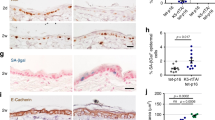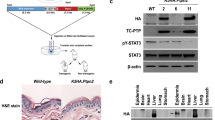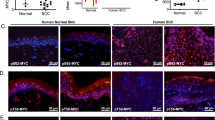Abstract
Aneuploidy is found in most solid tumours, but it remains unclear whether it is the cause or the consequence of tumorigenesis. Using Plk4 overexpression (PLK4OE) during epidermal development, we assess the impact of centrosome amplification and aneuploidy on skin development and tumorigenesis. PLK4OE in the developing epidermis induced centrosome amplification and multipolar divisions, leading to p53 stabilization and apoptosis of epidermal progenitors. The resulting delayed epidermal stratification led to skin barrier defects. Plk4 transgene expression was shut down postnatally in the surviving mice and PLK4OE mice never developed skin tumours. Concomitant PLK4OE and p53 deletion (PLK4OE/p53cKO) rescued the differentiation defects, but did not prevent the apoptosis of PLK4OE cells. Remarkably, the short-term presence of cells with supernumerary centrosomes in PLK4OE/p53cKO mice was sufficient to generate aneuploidy in the adult epidermis and triggered spontaneous skin cancers with complete penetrance. These results reveal that aneuploidy induced by transient centrosome amplification can accelerate tumorigenesis in p53-deficient cells.
This is a preview of subscription content, access via your institution
Access options
Subscribe to this journal
Receive 12 print issues and online access
$209.00 per year
only $17.42 per issue
Buy this article
- Purchase on Springer Link
- Instant access to full article PDF
Prices may be subject to local taxes which are calculated during checkout







Similar content being viewed by others
Change history
10 December 2015
In the version of this Article originally published online, Bram Boeckx and Diether Lambrechts should have had a second affiliation: Vesalius Research Center, VIB, 3000 Leuven, Belgium. This is now correct in all versions of the Article.
References
Nigg, E. A. & Raff, J. W. Centrioles, centrosomes, and cilia in health and disease. Cell 139, 663–678 (2009).
Bettencourt-Dias, M., Hildebrandt, F., Pellman, D., Woods, G. & Godinho, S. A. Centrosomes and cilia in human disease. Trends Genet. 27, 307–315 (2011).
Firat-Karalar, E. N. & Stearns, T. The centriole duplication cycle. Phil. Trans. R. Soc. 369, 20130460 (2014).
Anderhub, S. J., Kramer, A. & Maier, B. Centrosome amplification in tumorigenesis. Cancer Lett. 322, 8–17 (2012).
Boveri, T. Concerning the origin of malignant tumours by Theodor Boveri. Translated and annotated by Henry Harris. J. Cell Sci. 121, 1–84 (2008).
Lingle, W. L. et al. Centrosome amplification drives chromosomal instability in breast tumor development. Proc. Natl Acad. Sci. USA 99, 1978–1983 (2002).
Pihan, G. A., Wallace, J., Zhou, Y. & Doxsey, S. J. Centrosome abnormalities and chromosome instability occur together in pre-invasive carcinomas. Cancer Res. 63, 1398–1404 (2003).
Holland, A. J. & Cleveland, D. W. Boveri revisited: chromosomal instability, aneuploidy and tumorigenesis. Nat. Rev. Mol. Cell Biol. 10, 478–487 (2009).
Weaver, B. A. & Cleveland, D. W. Does aneuploidy cause cancer? Curr. Opin. Cell Biol. 18, 658–667 (2006).
Foijer, F. et al. Spindle checkpoint deficiency is tolerated by murine epidermal cells but not hair follicle stem cells. Proc. Natl Acad. Sci. USA 110, 2928–2933 (2013).
Torchia, E. C., Zhang, L., Huebner, A. J., Sen, S. & Roop, D. R. Aurora kinase-A deficiency during skin development impairs cell division and stratification. J. Invest. Dermatol. 133, 78–86 (2013).
Solomon, D. A. et al. Mutational inactivation of STAG2 causes aneuploidy in human cancer. Science 333, 1039–1043 (2011).
Ricke, R. M., Jeganathan, K. B. & van Deursen, J. M. Bub1 overexpression induces aneuploidy and tumor formation through Aurora B kinase hyperactivation. J. Cell Biol. 193, 1049–1064 (2011).
Rao, C. V. et al. Colonic tumorigenesis in BubR1+/-ApcMin/+ compound mutant mice is linked to premature separation of sister chromatids and enhanced genomic instability. Proc. Natl Acad. Sci. USA 102, 4365–4370 (2005).
Weaver, B. A., Silk, A. D., Montagna, C., Verdier-Pinard, P. & Cleveland, D. W. Aneuploidy acts both oncogenically and as a tumor suppressor. Cancer Cell 11, 25–36 (2007).
Chesnokova, V., Kovacs, K., Castro, A. V., Zonis, S. & Melmed, S. Pituitary hypoplasia in Pttg-/- mice is protective for Rb+/- pituitary tumorigenesis. Mol. Endocrinol. 19, 2371–2379 (2005).
Sussan, T. E., Yang, A., Li, F., Ostrowski, M. C. & Reeves, R. H. Trisomy represses Apc(Min)-mediated tumours in mouse models of Down’s syndrome. Nature 451, 73–75 (2008).
Zyss, D. & Gergely, F. Centrosome function in cancer: guilty or innocent? Trends Cell Biol. 19, 334–346 (2009).
Basto, R. et al. Centrosome amplification can initiate tumorigenesis in flies. Cell 133, 1032–1042 (2008).
Sabino, D. et al. Moesin is a major regulator of centrosome behavior in epithelial cells with extra centrosomes. Curr. Biol. 25, 879–889 (2015).
Marthiens, V. et al. Centrosome amplification causes microcephaly. Nat. Cell Biol. 15, 731–740 (2013).
Perez-Losada, J. & Balmain, A. Stem-cell hierarchy in skin cancer. Nat. Rev. Cancer 3, 434–443 (2003).
Boukamp, P. Non-melanoma skin cancer: what drives tumor development and progression? Carcinogenesis 26, 1657–1667 (2005).
Nassar, D., Latil, M., Boeckx, B., Lambrechts, D. & Blanpain, C. Genomic landscape of carcinogen and genetically-induced mouse skin squamous cell carcinoma. Nat. Med. 8, 946–954 (2015).
McGranahan, N., Burrell, R. A., Endesfelder, D., Novelli, M. R. & Swanton, C. Cancer chromosomal instability: therapeutic and diagnostic challenges. EMBO Rep. 13, 528–538 (2012).
Vasioukhin, V., Degenstein, L., Wise, B. & Fuchs, E. The magical touch: genome targeting in epidermal stem cells induced by tamoxifen application to mouse skin. Proc. Natl Acad. Sci. USA 96, 8551–8556 (1999).
Sotiropoulou, P. A. & Blanpain, C. Development and homeostasis of the skin epidermis. Cold Spring Harb. Perspect. Biol. 4, a008383 (2012).
Kleylein-Sohn, J. et al. Plk4-induced centriole biogenesis in human cells. Dev. Cell 13, 190–202 (2007).
Holland, A. J. et al. The autoregulated instability of Polo-like kinase 4 limits centrosome duplication to once per cell cycle. Genes Dev. 26, 2684–2689 (2012).
Blanpain, C., Lowry, W. E., Pasolli, H. A. & Fuchs, E. Canonical notch signaling functions as a commitment switch in the epidermal lineage. Genes Dev. 20, 3022–3035 (2006).
Koster, M. I. & Roop, D. R. Mechanisms regulating epithelial stratification. Annu. Rev. Cell Dev. Biol. 23, 93–113 (2007).
Sancar, A., Lindsey-Boltz, L. A., Unsal-Kacmaz, K. & Linn, S. Molecular mechanisms of mammalian DNA repair and the DNA damage checkpoints. Annu. Rev. Biochem. 73, 39–85 (2004).
Sotiropoulou, P. A. et al. Bcl-2 and accelerated DNA repair mediates resistance of hair follicle bulge stem cells to DNA-damage-induced cell death. Nat. Cell Biol. 12, 572–582 (2010).
Lechler, T. & Fuchs, E. Asymmetric cell divisions promote stratification and differentiation of mammalian skin. Nature 437, 275–280 (2005).
Williams, S. E., Ratliff, L. A., Postiglione, M. P., Knoblich, J. A. & Fuchs, E. Par3-mInsc and Galphai3 cooperate to promote oriented epidermal cell divisions through LGN. Nat. Cell Biol. 16, 758–769 (2014).
Izumi, H. & Kaneko, Y. Evidence of asymmetric cell division and centrosome inheritance in human neuroblastoma cells. Proc. Natl Acad. Sci. USA 109, 18048–18053 (2012).
Liu, X. et al. Somatic loss of BRCA1 and p53 in mice induces mammary tumors with features of human BRCA1-mutated basal-like breast cancer. Proc. Natl Acad. Sci. USA 104, 12111–12116 (2007).
Holland, A. J., Lan, W., Niessen, S., Hoover, H. & Cleveland, D. W. Polo-like kinase 4 kinase activity limits centrosome overduplication by autoregulating its own stability. J. Cell Biol. 188, 191–198 (2010).
Ziegler, A. et al. Sunburn and p53 in the onset of skin cancer. Nature 372, 773–776 (1994).
Berg, R. J. et al. Early p53 alterations in mouse skin carcinogenesis by UVB radiation: immunohistochemical detection of mutant p53 protein in clusters of preneoplastic epidermal cells. Proc. Natl Acad. Sci. USA 93, 274–278 (1996).
Ruggeri, B. et al. Alterations of the p53 tumor suppressor gene during mouse skin tumor progression. Cancer Res. 51, 6615–6621 (1991).
Jonkers, J. et al. Synergistic tumor suppressor activity of BRCA2 and p53 in a conditional mouse model for breast cancer. Nat. Genet. 29, 418–425 (2001).
Sotiropoulou, P. A. et al. BRCA1 deficiency in skin epidermis leads to selective loss of hair follicle stem cells and their progeny. Genes Dev. 27, 39–51 (2013).
Acknowledgements
C.B. is an investigator of WELBIO; Ö.S. is supported by a TELEVIE fellowship. This work was supported by the FNRS, TELEVIE, the PAI programme, a research grant from the Fondation contre le Cancer, the ULB Fondation, the foundation Bettencourt Schueller, the foundation Baillet Latour, a grant from the European Research Council (ERC) and a grant from AICR now worldwide cancer research (13-0170) to V.M. and R.B.
Author information
Authors and Affiliations
Contributions
Ö.S. and C.B. designed the experiments and performed data analysis; Ö.S. performed most of the experiments, J.-C.L. and A.E.K. conducted proliferation experiments; V.M. performed RNA purification; M.L.M. performed FISH experiments; D.L. and B.B. performed tumour sequencing and analysis. V.Ma. and R.B. generated the PLK4OE mice; Ö.S. and C.B. wrote the manuscript.
Corresponding author
Ethics declarations
Competing interests
The authors declare no competing financial interests.
Integrated supplementary information
Supplementary Figure 1 Schematic representation of transgene recombination.
(a) A loxp-STOP-loxp cassette prevents expression of mCherry-Plk4 construct. (b) Upon initiation of K14 expression in mouse skin epidermis, Cre accumulates and recombines loxP sites and enables Plk4 overexpression in mice older than E14. Unrecombined and recombined specific primers and PCR are detailed in Methods.
Supplementary Figure 2 mCherry-Plk4 localizes to centrosomes in mouse skin epidermis and causes centrosome supernumerary.
(a) Keratinocytes extracted from E16.5 embryos were stained for centrosome marker γ-tubulin. mCherry-Plk4 co-localizes with γ-tubulin, insets show higher magnification of the same image for co-localization. (b) Quantification of percentage of cells mCherry-positive and cells with >2 centrosomes. Data represent the mean of n = 3 mice. (≥30 cells per mouse were counted) Nuclei were stained with DAPI and white scale bars represent 5 μm. Source data are available in Supplementary Table 1.
Supplementary Figure 3 Plk4 overexpression causes skin development defects.
(a) Newborn PLK4OE mice show shiny skin and open eyes. (b) Close up image of (a) reveals incomplete eyelid formation in PLK4OE but not control mice. (c,d) Macroscopic image of newborn mice show that only PLK4OE but not control mice exhibit shiny face (c) and back skin (d).
Supplementary Figure 4 PCR of recombined and unrecombined Plk4 transgene.
(a) Recombination of the transgene was detected by genomic PCR only in double transgenic mouse at E16.5, P1, adult and in different tumours but not in control mice or CRE negative mice, non-recombined allele was detected by a primer designed specifically to amplify the cells which did not recombine the transgene. ß-actin was used as a loading control.
Supplementary Figure 5 Expression of mCherry-PLK4 mRNA is lost in adult mice.
(a) Expression of mCherry-Plk4 was tested by RT-PCR in P1 and adult mice. Only P1 but not adult PLK4OE and PLK4OE/p53cKO mice show amplification of the RT product. ß-actin was used as a loading control.
Supplementary information
Supplementary Information
Supplementary Information (PDF 39330 kb)
Supplementary Table 1
Supplementary Information (XLSX 50 kb)
Rights and permissions
About this article
Cite this article
Serçin, Ö., Larsimont, JC., Karambelas, A. et al. Transient PLK4 overexpression accelerates tumorigenesis in p53-deficient epidermis. Nat Cell Biol 18, 100–110 (2016). https://doi.org/10.1038/ncb3270
Received:
Accepted:
Published:
Issue Date:
DOI: https://doi.org/10.1038/ncb3270
This article is cited by
-
Preclinical characterization and clinical trial of CFI-400945, a polo-like kinase 4 inhibitor, in patients with relapsed/refractory acute myeloid leukemia and higher-risk myelodysplastic neoplasms
Leukemia (2023)
-
Polo-like kinase 4 (Plk4) potentiates anoikis-resistance of p53KO mammary epithelial cells by inducing a hybrid EMT phenotype
Cell Death & Disease (2023)
-
A novel HIF1α-STIL-FOXM1 axis regulates tumor metastasis
Journal of Biomedical Science (2022)
-
An updated view on the centrosome as a cell cycle regulator
Cell Division (2022)
-
Oncosuppressive functions of PIDD1 in response to centrosome amplification
Cell Death & Disease (2021)



